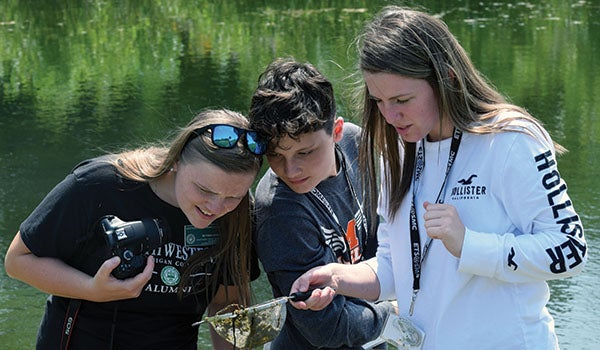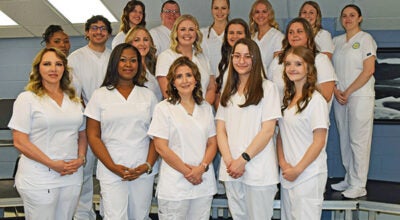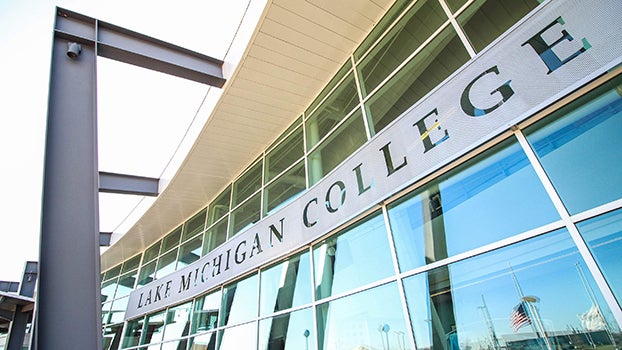SMC hosts agriculture camp
Published 9:23 am Monday, July 29, 2019

- ETS advisor Bethani Eichel of Dowagiac, Camden Cavender of Marcellus and Piper Ruff of Dowagiac scrutinize the bounty from a pond scoop. (Submitted photo)
DOWAGIAC —From July 22 to the 26, 18 middle schoolers took part in an Agriculture Science Camp as part of Southwestern Michigan College’s educational talent search. The students also visited the University of Notre Dame’s Linked Experimental Ecosystem Facility and were introduced to many animals from bald eagles to aquatic insects from a pond, organizers said.
ETS camp encompassed activities traditionally are associated with farming, past camps have included field trips to Corey Lake Orchards, a Cassopolis hog operation that included Jake’s Country Meats, Ag Innovation Day at Michigan State University and a lively panel discussion with five professionals.
Campers prepared lunch with produce, including blueberries they picked, from Corey Lake Orchards Farm Market near Three Rivers to serve at Garden Party hosted on Thursday for SMC staff and faculty.
ND-LEEF provides scientists with a place to do large-scale experiments without the challenges of field research, where controlling and replicating experiments can be problematic. It houses two man-made experimental watersheds, each consisting of an interconnected pond, stream and wetland. Both experimental watersheds are roughly the length and width of a football field and located five miles north of campus on six acres within St. Patrick’s County Park.
ND-LEEF is unique because the pond, stream and wetland created in 2013 in each watershed are connected — an experimental research design intended to mimic nature. Streams, ponds and wetlands at ND-LEEF can be disconnected from one another for a given experiment, providing scientists with maximum flexibility in designing research projects. Students met two actual researchers on July 23 who are Notre Dame graduate students — one from South Korea.
According to organizers, the camp participants were divided into three groups of six, students switched between segments on bald eagles, macroinvertebrate sampling and watersheds and stream flow measurement. Since Macroinvertebrates lack backbones, their presence in a waterway provides an indicator to water quality.
In spring 2015, two bald eagles took over an existing red-tailed hawk nest and fledged one eaglet. These eagles, as well as a pair from Potato Creek State Park, were the first successful bald eagle nests recorded in St. Joseph County, Ind, researchers from ND-LEEF said.
The eagles returned to build up their nests in the winters of 2016, 2017 and 2018. A live camera was mounted above the nest in autumn 2017 so web viewers can watch the nest being built, eggs being laid and incubated and eaglets as they hatch and reach the fledgling stage. Two adults and three young eagles occupied it this year, researchers said.
“I get to see eagles while teaching about Nature, said Park Interpreter Michaelle Klingerman of Niles. “When I was in third grade (1974, when numbers dwindled to 791), we almost lost them.” The population rebounded after the insecticide DDT was outlawed, therefore bald eagles were removed from the endangered species lists in 2007, Klingerman said.
“The guys flying around up there were born in April,” she said. “Eagles have amazing sight. If you put one on a football field goalpost, it could read a newspaper in the opposite end zone.”
Bald eagles also see in color with binocular vision, which lets them focus one eye at something near and the other at a distant point. Spicules, which are bumps on their feet — help pluck slippery fish from the St. Joseph River. Also, Females are larger than males, Klingerman said.
Over at the pond, Jill McDonald distributed strainers to the students to scoop mayfly nymphs with feathery external gills that “are very intolerant of pollution.” Students also found dragonfly and damselfly nymphs, frogs, a snail, backswimmers and water boatmen.
“Dragonflies are nicknamed ‘mosquito hawks’ for what they like to eat,” McDonald said.
Assistant Director Brett Peters illustrated watershed runoff by spreading a white shower curtain and sprinkling the topography with photos of golf courses, farm fields and subdivisions, “motor oil” (soy sauce) and “manure” (cocoa), he swamped with a watering can.
Floating a ping pong ball, Peters juggled a white board and rulers as they calculated discharge volume of 2.9 liters per second measuring stream velocity, distance and depth of a cross-sectional area.
“Agriculture is a very broad spectrum,” ETS Director Maria Kulka said. “This camp easily could have been multiple weeks. I hope students take away from this experience how agriculture ties into every single thing they do every day. I focused on the farm-to-table movement,”
The movement helps promotes serving local food from restaurants to school cafeterias, often through direct acquisition from producers, Kulka said.
Representatives from Michigan State University emphasized agricultural technology.
“You can get into agriculture with any degree,” said one panelist. “There’s so much more to agriculture camp than wanting to be a farmer. I’m passionate about agriculture and want to open their eyes to that.”






